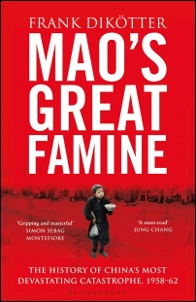|
by Alice Tsay

Frank Dikötter, Mao's Great Famine, Bloomsbury, 2010. 421 pgs. 'Revolution is not a dinner party.' —Mao Zedong, epigraph to Mao's Great Famine
In Mao's Great Famine: The History of China's Most Devastating Catastrophe, 1956-62, Frank Dikötter portrays the usual elements that accompany a nation's descent into a state of desperation: systematic inefficiency, depletion of resources, individual venality, occasional cowardice, faulty ideology, pervasive censorship, towering egos. The true value of the historian's latest book, which was awarded the 2011 Samuel Johnson Prize for Non-Fiction, however, is the extent to which it goes beyond these tropes. His revision of the famine's death toll is only a start, horrifying as it is to think of an increase from previous estimates of between 30 and 38 million to 'a minimum of 45 million.' Though this figure will likely become the most cited part of the book, the historian's true subject is the famine's astonishing variety of causes, consequences and manifestations. Of the six parts into which Dikötter divides Mao's Great Famine, "Destruction" has five subsections, "Survival" six, and "Ways of Dying" seven. Dikötter's methods reflect a thoroughness equal to the physical, environmental and psychological devastation he describes. The particulars revealed in this work range from extensions of the imaginable to severe transgressions of the human mind: Harking back to a traditional practice called chiqing, or 'eating green', villagers quietly clipped off spikes of grain straight from the field, husked and ground it in their hands and ate the raw, green kernels when out of sight of the militia.
Wu Jingxi got five yuan for his nine-year-old son from a stranger, a sum which covered the cost of a bowl of rice and two kilos of peanuts….But many [parents], of course, never found a buyer for their children.
Roughly one out of ten primary school children in Jilin speculated in cakes, meat, eggs, vegetables or soap.
Inside the house were four large cauldrons in which corpses were being simmered into fertiliser, the extract to be evenly distributed over the fields.
There is a touch of grace in Dikötter's lucidity, in the way his impassive prose underscores how during this period the terrible became nearly mundane. Elsewhere, flashes of ironic humour serve a similar role: Close cropping was the cornerstone of innovative tilling. Seeds too, it seemed, showed a revolutionary spirit, those belonging to the same class sharing light and nutrients in a spurt of equality.
Why? may never be an answerable question. However, in drawing out unexpected connections between aspects of the famine through passages such as the one above, Dikötter demonstrates how the dominant ideologies subtly percolated into all areas of thought and practice, making painfully possible the otherwise ludicrous. Reading biographies or historical works, the impulse is to page over to the photographic inserts in order to gain a mental image of the subject and find a foothold for understanding. Though the pictures in Mao's Great Famine serve this purpose powerfully, they do so in a roundabout way. 'No known photographs other than those taken for propaganda purposes are known to exist from the years of the famine,' Dikötter notes. Instead of illustrating the narrative, the given images thus stimulate a projection of the unseen. In fact, it is a section haunted not only by the invisible presences of those whose faces and experiences remained hidden away from camera lenses, but also of some who made it into the spotlight but were excised down the road. The caption for a 1958 photo of Mao breaking ground at the Ming Tomb Reservoir, for example, contains the following remark: '(the original photo also shows Peng Zhen, the mayor of Beijing, but he was later airbrushed out of the picture).' The most disturbing part in the end, however, is not what we learn here about the Communist party's tampering with evidence or their intention to deceive. It is not that after describing the extraordinary inefficiencies and casualties associated with the building of the Ming Tombs Reservoir, Dikötter bleakly reveals that as it was 'built in the wrong location, it dried up and was abandoned after a few years.' It is that, even after close inspection of this photograph of Mao wielding his shovel symbolically at the construction site, the parenthetical above remains the only definite trace of Peng Zhen to be found. We like to think that a greater handle on the facts equips us for superior perception of the truth. Factual accuracy is certainly an important step, but Dikötter's important account reminds us that grappling with the highs and lows of human experience is far more difficult, far more complicated than that. |